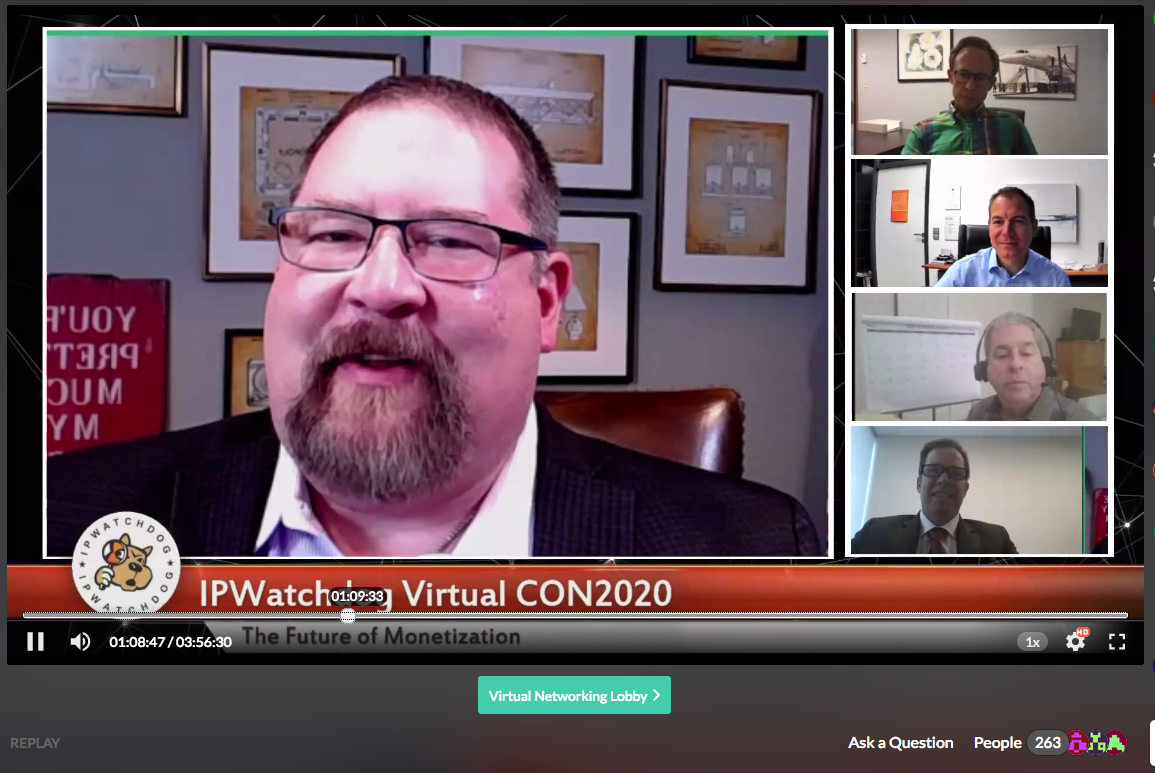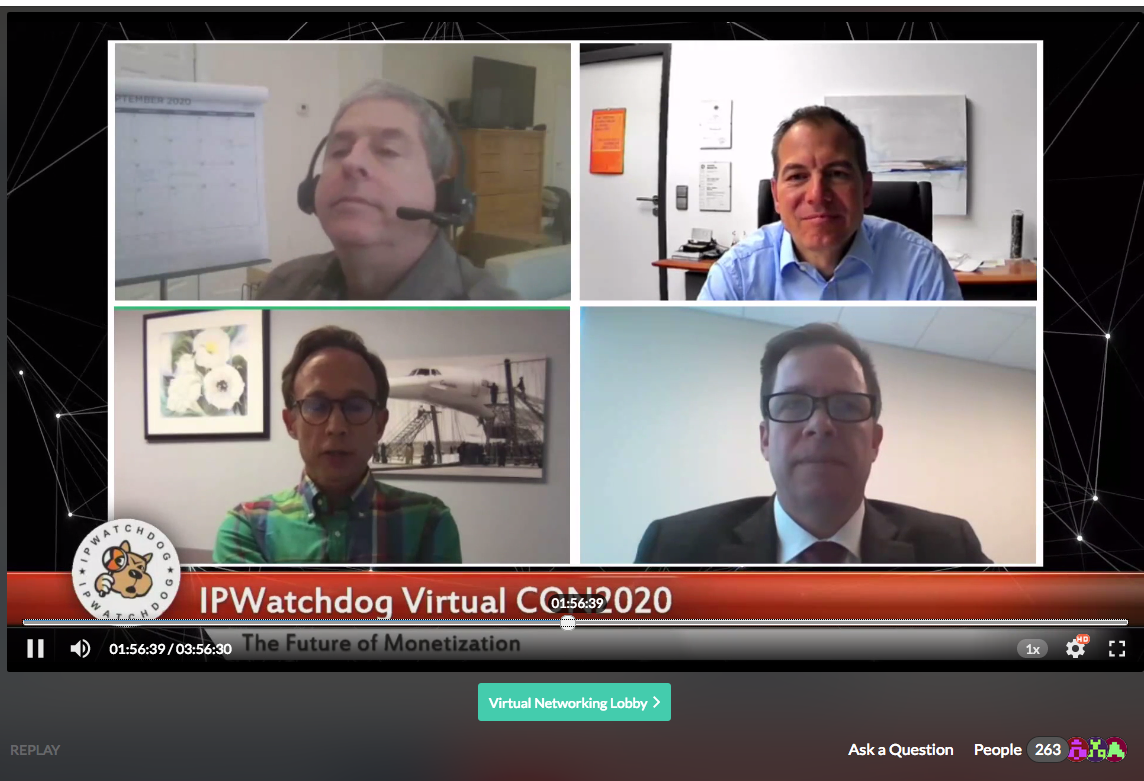“Fish said that there is more money that is chasing a smaller number and high quality amount of deals, ‘and that portends well for the future.’”
On the penultimate day of IPWatchdog’s CON2020, a session titled “The Future of Monetization” featured a panel of experts discussing how the changing patent policy landscape in the United States continues to alter business models and monetization strategies for associated patents worldwide. The panelists discussed what the future of patent monetization looks like and factors influencing expectations of success.
Is Monetization Getting Better, Worse, or Staying the Same?
Gene Quinn , President & CEO of IPWatchdog, Inc., asked each panelist their viewpoint on whether monetization of patents is getting better, worse, or staying the same. Daniel Papst, Managing Director and Co-Owner of Papst Licensing GmbH & Co., said that he is hopeful things will become better in the future. “The most dire times are behind us; it looks like the market is filled with more liquidity. There have always been portfolios out there that appear to be worth monetizing, and the courts, especially in the U.S., seem to be getting a little more rational again.”
, President & CEO of IPWatchdog, Inc., asked each panelist their viewpoint on whether monetization of patents is getting better, worse, or staying the same. Daniel Papst, Managing Director and Co-Owner of Papst Licensing GmbH & Co., said that he is hopeful things will become better in the future. “The most dire times are behind us; it looks like the market is filled with more liquidity. There have always been portfolios out there that appear to be worth monetizing, and the courts, especially in the U.S., seem to be getting a little more rational again.”
Ed Fish, Co-founder and Managing Director at Tech+IP Capital, added that there are a number of data points that suggest monetization has been getting better over the past six to eight months, and that the market is returning. For example, he noted that there have been significant decisions in the UK relating to FRAND (fair, reasonable and non-discriminatory) terms and injunctions being granted in Germany in the context of wireless communications. The pendulum is shifting back “slowly but surely” around Alice and IPRs, said Fish, and there have been “some nice judgments starting to come out of Texas.” Fish also said that there is more money that is chasing a – relatively speaking – smaller number and high quality amount of deals, “and that portends well for the future.”
Michael Gulliford, Founder and a Managing Principal of Soryn IP Group, explained that the market was pretty much dead around 2013-2014, and referred to an article he authored in 2014 titled, “If Patent Reform Is Meant to Starve Patent Trolls, Why Is It Feeding Them Instead? In that article, he explained that “the reform to date has had the unintended effect of creating more opportunity for NPEs, while making it substantially more difficult for innovators without millions of dollars in the bank to protect their intellectual property.” Gulliford said Tuesday that the market today is in a better place than 2014 from a policy perspective.  He noted that decisions in the FRAND world show that there seems to be a reckoning in Europe, in the UK and Germany and in the United States, but there is a greater problem with companies holding out by refusing to do licenses. He said that, in the COVID world, there seems to be a call to innovation and that people seem to be waking up to the need for more U.S. innovation which will inevitably require strengthening of the patent system.
He noted that decisions in the FRAND world show that there seems to be a reckoning in Europe, in the UK and Germany and in the United States, but there is a greater problem with companies holding out by refusing to do licenses. He said that, in the COVID world, there seems to be a call to innovation and that people seem to be waking up to the need for more U.S. innovation which will inevitably require strengthening of the patent system.
Adam Gill, Founder & Managing Director of GLS Capital, agreed that things have been getting better, noting that there is more predictability and, from an investor’s standpoint, it is important to have predictability and stability so investors can calculate how the Patent Trial and Appeal Board (PTAB) or Federal Circuit will decide something. He explained that “as long as there is a predictable playing field and predictable rules we can enter [the market] with an expectation of success.”
Expectations of Success
The panelists also discussed whether expectations of success have become better or worse. Gill responded that he typically does not take on cases that have significant Section 101 patent eligibility risks, since if he cannot explain how a case will win, it will not meet the underwriting standards. Gulliford noted that FRAND and SEPs provide some certainty, especially overseas, and it is beginning to trickle down to deal making and values. Gill also said that a handful of patents is much different than when you have a large portfolio and explained that there is no “magic number” of assertable patents in a portfolio. Gulliford explained that, at both sides of the spectrum, small portfolios and large portfolios, there is an intangible line at which a business deal makes more sense than repeated litigation.
The panelists concluded that there is a future for the monetization of patents and agreed that patent quality is particularly important. Gill noted that, with quality patents, there are multiple financing vehicles for monetization.

![[IPWatchdog Logo]](https://ipwatchdog.com/wp-content/themes/IPWatchdog%20-%202023/assets/images/temp/logo-small@2x.png)

![[Advertisement]](https://ipwatchdog.com/wp-content/uploads/2024/04/UnitedLex-May-2-2024-sidebar-700x500-1.jpg)
![[Advertisement]](https://ipwatchdog.com/wp-content/uploads/2024/04/Artificial-Intelligence-2024-REPLAY-sidebar-700x500-corrected.jpg)
![[Advertisement]](https://ipwatchdog.com/wp-content/uploads/2024/04/Patent-Litigation-Masters-2024-sidebar-700x500-1.jpg)

![[Advertisement]](https://ipwatchdog.com/wp-content/uploads/2021/12/WEBINAR-336-x-280-px.png)
![[Advertisement]](https://ipwatchdog.com/wp-content/uploads/2021/12/2021-Patent-Practice-on-Demand-recorded-Feb-2021-336-x-280.jpg)
![[Advertisement]](https://ipwatchdog.com/wp-content/uploads/2021/12/Ad-4-The-Invent-Patent-System™.png)






Join the Discussion
One comment so far.
Anonymous
October 6, 2020 09:20 amSo long as you have the big tech companies influencing decisions at the PTAB and in their home states (Northern California) most patent owners will not have a chance to monetize their patents. It is only on rare occasions that small companies and inventors are successful in enforcing their patents.
A huge problem I see is where the PTAB upholds a patent and the when an owner goes to Federal court to enforce their patent the claims are most often invalidated. This leaves the patent owner with no other means to enforce or monetize their patents.
Reforms must still be made at the PTAB to stop big tech companies from filing multiple redundant challenges.
Still many changes need to be made before patent owners have a real chance of monetizing their patents.